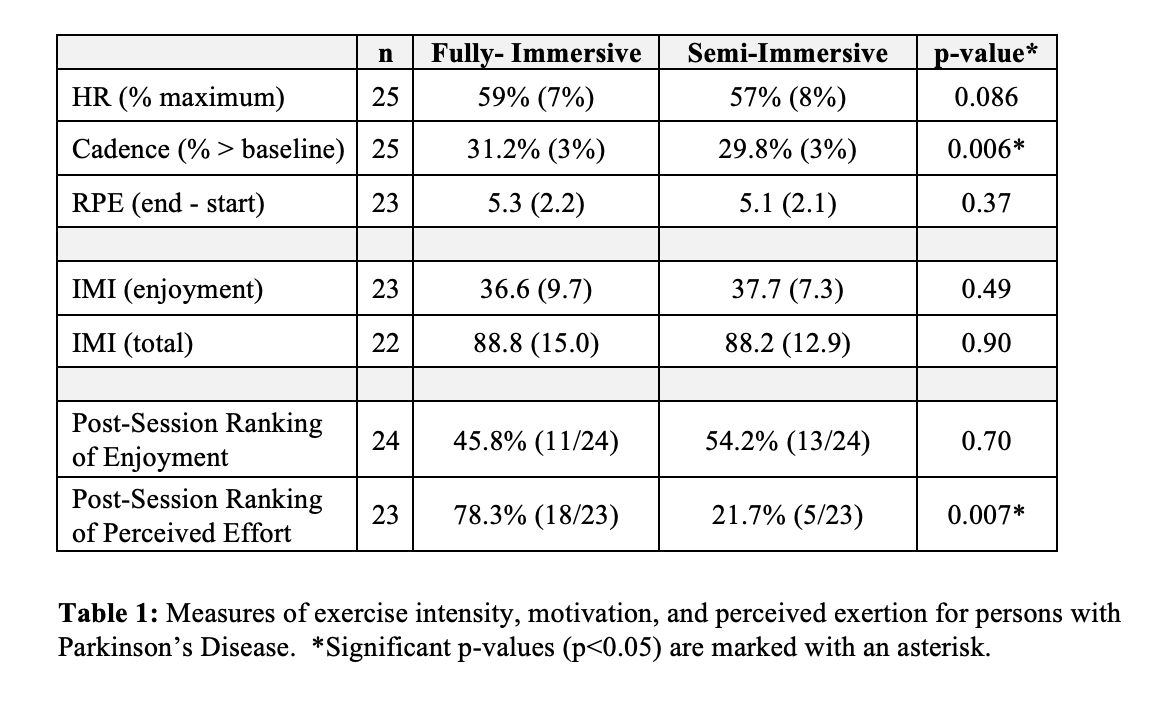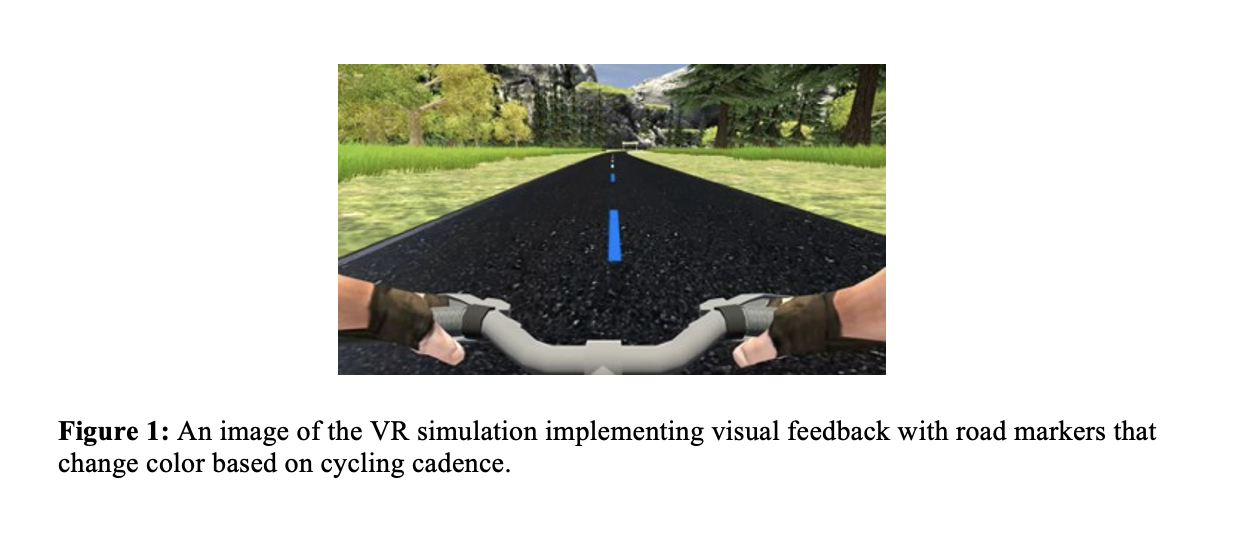Category: Technology
Objective: The purpose of this study was to determine the effect of immersion level in virtual reality (VR) on exercise intensity and motivation for persons with Parkinson Disease (PwPD).
Background: Auditory cueing and visual feedback in semi immersive VR have been shown to increase neuromuscular exercise intensity (cycling cadence) for PwPD. [1] Whether fully immersive VR has a comparable or stronger effect on neuromuscular and cardiovascular intensity as well as motivation is unknown.
Method: Participants with Parkinson Disease (n=25) bicycled in 2 different VR conditions for 5 minutes each. The fully immersive condition was delivered with a head-mounted display. The semi immersive condition was viewed on a large screen. The simulation created in Unity 3D used a first-person perspective as the cyclist navigated through a forest landscape. Visual feedback using road markers prompted riders to maintain a target cadence of 25-40% faster than their comfortable bicycling cadence. [1] During both conditions, cycling cadence and heart rate (HR) as a percentage of maximum HR were acquired at 1 Hz. [2] Rating of perceived exertion (RPE) was recorded at the start, middle, and end of each condition. [3] Participants completed an Intrinsic Motivation Inventory (IMI) after each condition. [4] Ratings of enjoyment and effort were solicited once both trials were completed. Data were analyzed using paired t-tests for: average HR, average cadence, changes in RPE from start to end of trial, enjoyment subscale of IMI, total IMI.
Results: Participants had a significantly higher cadence in fully immersive VR (p = 0.006, see table 1), but they did not have a significantly higher RPE while cycling (p=0.37). There were no significant differences between conditions for motivation or enjoyment. When ranking the two conditions, participants did not prefer fully immersive compared to semi immersive VR, but they did report working harder during fully immersive VR.
Conclusion: PwPD exercised at a higher neuromuscular intensity in fully immersive VR without perceiving they were working harder during the trial. Therefore, for exercise strategies with the goal of increasing exercise intensity for PwPD, fully immersive VR should be used.
References: 1. Gallagher R, Damodaran H, Werner WG, Powell W, Deutsch JE. Auditory and visual cueing modulate cycling speed of older adults and persons with Parkinson’s disease in a Virtual Cycling (V-Cycle) system. Journal of NeuroEngineering and Rehabilitation. 2016/08/19 2016;13(1):77. doi:10.1186/s12984-016-0184-z
2. Karvonen MJ, Kentala E, Mustala O. The effects of training on heart rate; a longitudinal study. Ann Med Exp Biol Fenn. 1957;35(3):307-15.
3. Penko AL, Barkley JE, Koop MM, Alberts JL. Borg scale is valid for ratings of perceived exertion for individuals with Parkinson’s disease. Int J Exerc Sci. 2017;10(1):76-86.
4. McAuley E, Duncan T, Tammen VV. Psychometric properties of the Intrinsic Motivation Inventory in a competitive sport setting: a confirmatory factor analysis. Res Q Exerc Sport. Mar 1989;60(1):48-58. doi:10.1080/02701367.1989.10607413
To cite this abstract in AMA style:
J. Palmieri, R. Gallagher, J. Donoghue, N. Volino, H. Damodaran, J. Deutsch. Effects of Virtual Reality Immersion Level on Exercise Intensity and Motivation for Persons with Parkinson Disease [abstract]. Mov Disord. 2022; 37 (suppl 2). https://www.mdsabstracts.org/abstract/effects-of-virtual-reality-immersion-level-on-exercise-intensity-and-motivation-for-persons-with-parkinson-disease/. Accessed December 5, 2025.« Back to 2022 International Congress
MDS Abstracts - https://www.mdsabstracts.org/abstract/effects-of-virtual-reality-immersion-level-on-exercise-intensity-and-motivation-for-persons-with-parkinson-disease/


